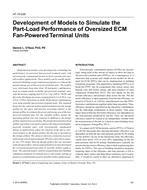Description
Mathematical models were developed for estimating theperformance of oversized fan-powered terminal units withelectronically commutated motors in both constant and variableairflow applications. These models can be readily implementedin building energy simulation programs to estimate theannual energy use of fan-powered terminal units. The modelswere developed from data from 36 fan/motor combinationsused in commercially available fan-powered terminal unitswith fan motors ranging from 0.33 to 1 hp (249 to 746 W) andfan static discharge pressures ranging from 0.1 to 0.50 in. w.g.(25 to 125 Pa). Data from six of the 36 fan/motor combinationswere from parallel fan-powered terminal units. The requiredinputs for the constant airflow model included only the designairflow for the space and fraction oversizing relative to thedesign airflow to estimate the power and energy use of the fanpoweredterminal unit. For the variable airflow model, theoperating airflow rate was required in addition to the designairflow and fraction oversizing. The model developed for fixedairflow operations was used to analyze the impact of using fanpoweredterminal units with electronically commutatedmotors in applications where the capacity of the unit is oversizedrelative to the design airflow but the unit is operated atthe design airflow. The analysis showed a reduction in power(and energy use) of approximately30%for a unit whose capacitywas 25% larger than the design airflow but was operatedat the design airflow.Amore general modelwasalso developedfor oversized fan-powered units in variable airflow applications.This general model could be programmed into buildingsimulation programs to estimate power and energy savings offan power terminal units used in variable airflow applications.
Citation: 2015 Annual Conference, Atlanta, GA, Transactions 2015, Vol 121 pt. 2
Product Details
- Published:
- 2015
- Number of Pages:
- 13
- Units of Measure:
- Dual
- File Size:
- 1 file , 2.1 MB
- Product Code(s):
- D-AT-15-026




